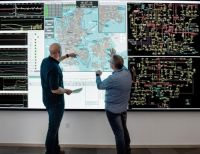More biological cameras
Today, robots and self-driving machines mainly use cameras and Lidar, a laser technology that can measure distances, but the SAVA project will also test infrared cameras and thermal cameras that can better detect animals and people in the surroundings.
In addition, the project will test so-called neuromorphic cameras (also known as event-based cameras), which function more like our eyes and only register when something changes in the image, rather than constantly registering everything in the image. Whereas the best DSLR cameras can capture around 120 frames per second, a neuromorphic camera can take up to 1,000,000 frames per second. Lazaros Nalpantidis hopes that this kind of technology can help the robots react significantly faster to unforeseen obstacles and come to a stop if, for instance, an animal or a person suddenly runs in front of them (in Denmark, approx. 20,000 deer fawns are killed by agricultural machines every year, according to Denmark's Hunters' Association).
Agricultural paradigm shiftRobots can fundamentally change the appearance of our fields. As agricultural robots tend to be significantly smaller than traditional agricultural machines, they can be adapted to a smaller area without sacrificing efficiency.
This means that you can plant narrow strips of several different crops next to each other, as the robots can sow, water, spray, and harvest in a narrow area.
Studies show that if you grow several different crops in an area, it’s better for biodiversity, as it provides habitats for more species, while there is less need for fertilizing and spraying with pesticides. If a crop is affected by pests or disease, it is limited to a single strip rather than an entire field.
In the long term, the robots can help change the entire landscape. In many places, the fields are moulded to the needs of large agricultural machines – streams are straightened out, low-lying areas drained, and hills leveled – but small robots will be able to follow nature’s shapes to a greater extent. Thus, more habitats for animals and plants can be preserved.
Robots within ten yearsTo get to that vision, the robots must first prove that they can operate safely and autonomously and not be of danger to their surroundings.
"Unfortunately, the robotic technology is not quite mature enough yet," says Lazaros Nalpantidis.
He acknowledges that robots are only a small part of the solution to the biodiversity crisis – and there will still be a need for large agricultural machines – but he hopes that robots can help make changes in parts of the world where industrial agriculture has not yet gained traction.
Ane Kirstine Aare also sees potential in robots.
"Some experience limitations with current agricultural machines when they wish to practice co-cultivation, so it’s really exciting to see what the robots can contribute. If robots are developed thoughtfully they may pave the way for a different kind of agriculture with more flexibility and local adaptation," she says.
To Lazaros Nalpantidis, his vision of robots chugging around in the fields might become reality within ten years.
"I am quite optimistic because there is momentum in this area and it is clear that we cannot continue with the current agricultural production. It’s just not sustainable," says Lazaros Nalpantidis.
"But in ten years’ time, we’ll have far more futuristic machines in agriculture."














